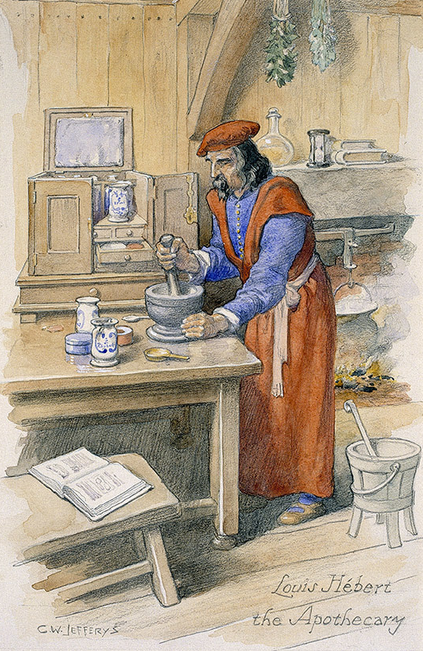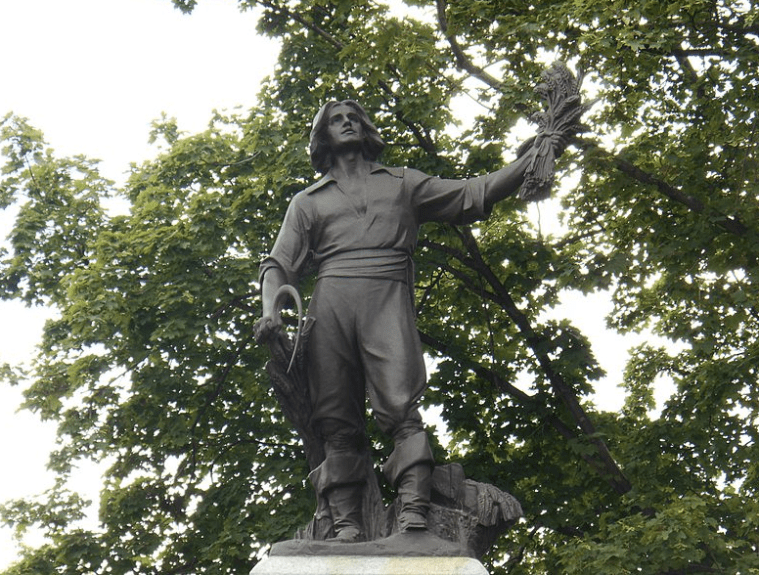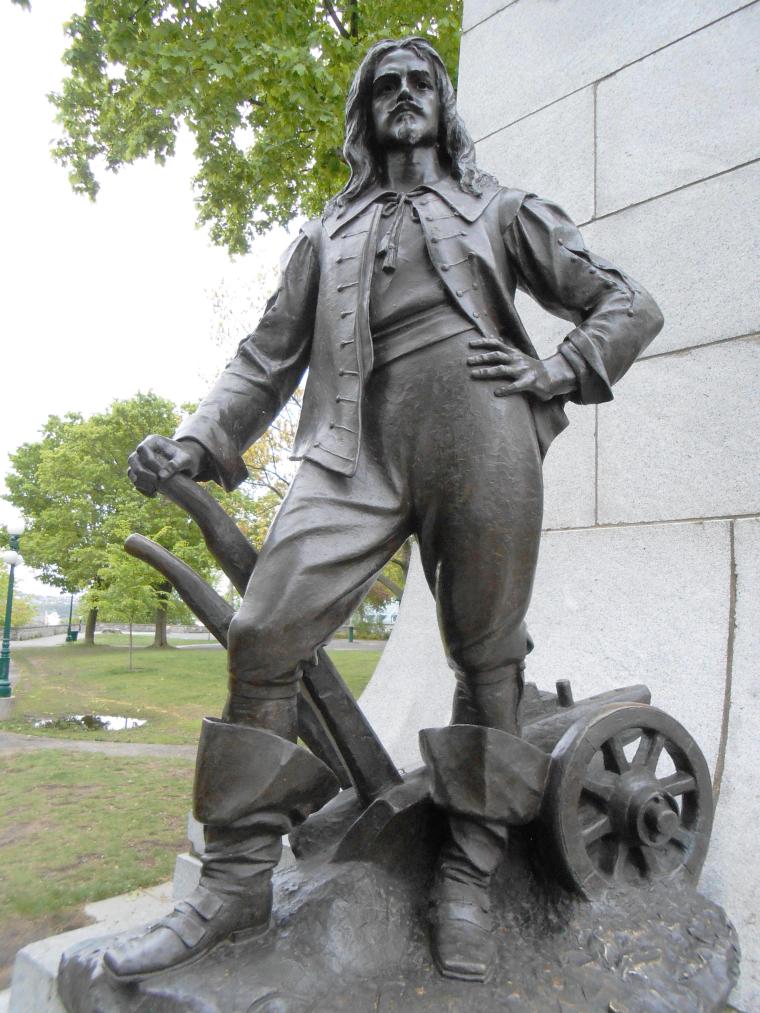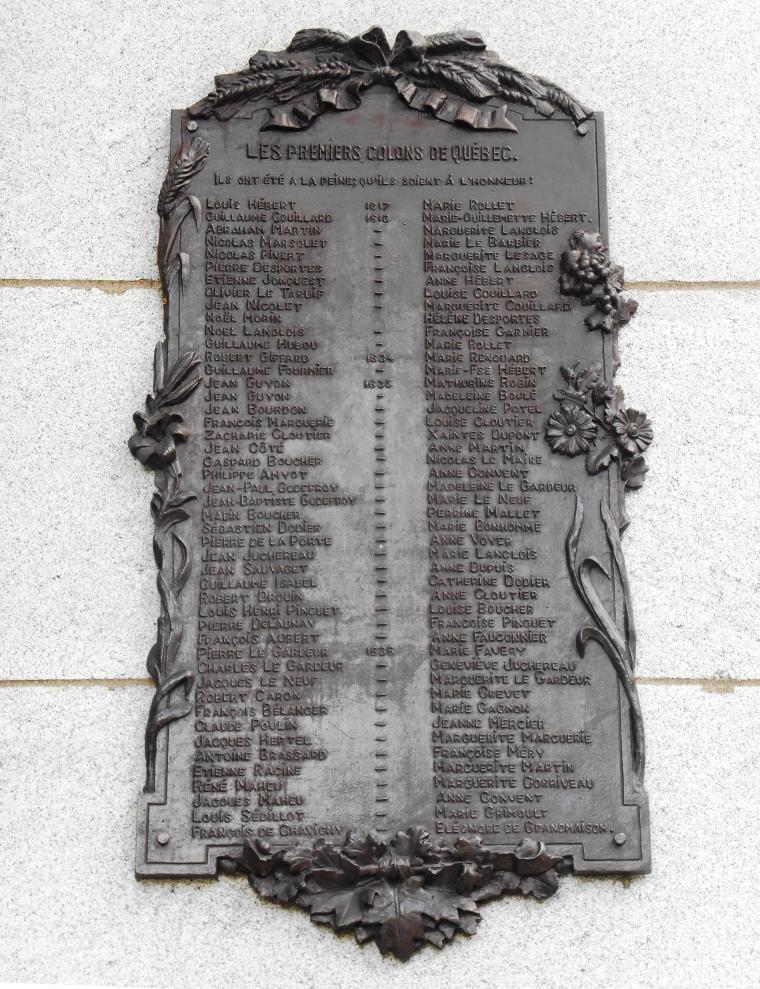In 1604, longing for adventure and wanting to escape the confines of Paris and explore new lands, Louis Gaston Hebert sailed to the unrivaled beauty of what was once known as New France. Enamored with the rugged magnificence of this continent, this man continued in his quests to view more of this world until he finally settled with his family in the Quebec Colony. Over the centuries, historical accounts recognized Hebert as one of the first settlers of this country.

This grandfather was born about 1575 in the home of his family, the Mortier D’ Or (the House of Gold) on the rue Saint-Honore in Paris, Seine, France. The infant’s mother was Jacqueline Pajot; she died when her son was about five years old. His father was Nicholas Hebert, a distinguished apothecary in Paris that also served the Royal Court of the Queen, Catherine de Medici.
Following in the steps of his father, Hebert studied medicine and science, and he was also a pharmacist. Throughout his life, he relished in learning about plants and enjoyed gardening. By the early seventeenth century, while living in Paris, this man practiced his art as an apothecary and a spice merchant. In 1603, he received the title of a master apothecary, and he owned a shop and a home in St-Germain-des-Pres, near the banks of the Seine.

17th century
On February 19, 1601, Hebert married Marie Rollet at the Church of Saint-Sulpice in Paris. The twenty-one-year-old bride was the widow of a merchant, Francois Dufeu. In 1602, the couple purchased their home at Rue de la Petite Seine. The couple added three children to their family, Anne (1602-1619), Marie Guillemette (1608-1684), and Guillaume (1614-1639).
Through his family, Hebert learned about the exciting, new opportunities that awaited in New France. His cousin, Pierre Dugua de Mon, left France behind to lead an expedition in this new world. In 1606, Hebert followed as he began his first of three journeys to New France. His cousin became the lieutenant-general of New France and longed to create a settlement in Acadia. Dugua de Mons hired Hebert to work in Port Royal (Annapolis Royal) in Nova Scotia. During this time, Hebert met Samuel de Champlain, the man known as “the Father of New France.”

During his time in Port Royal, Hebert was well known and respected for his agriculture methods and farming experiments. While in these new lands, Hebert also cared for the other settlers that worked in this settlement. A native tribe, the Micmac taught him about important indigenous plants, and the scientist cultivated these plants and added them to his growing gardens. Unfortunately, in 1607, the trade agreement contracted to Dugua de Mons was rescinded, and he lost the backing of the king. Settlers deserted the outpost, so Hebert returned to Paris.
In 1610, Hebert returned to Port Royal with his Uncle Jean de Biencourt de Poutrincourt, a French nobleman that was a commander that strived to colonize the lands in Acadia. Once again, Hebert tended the land and the people, including the natives that lived in the area. This time the settlement flourished until the colony was destroyed by the British in 1613. Hebert and his companions were forced to return to Paris.

Since Champlain recognized Hebert’s talents in Acadia, he asked this man to join him in a new venture, establishing a new settlement near the St. Lawrence River. Champlain asked Hebert to bring his family and live in the colony for at least three years. He promised Hebert annual salary of 600 livres; also, he would receive land.
Ready to start a new life with his family in a new land, Hebert sold his practice and his property. However, the Canada Company did not keep their word and refused to allow Hebert and his family to board the ship, Le Saint-Etienne, until he signed a new contract which cut his salary in half. Furthermore, it demanded that Hebert serve as a doctor and a surgeon, farm the ten acres of land, and allow the company to have exclusive rights to purchase his produce at a reduced price. Since he had sold all that he owned, Hebert half-heartedly accepted and signed the new contract.
The family set sail from the port of Honfleur, France on April 11, 1617, and arrived at the Quebec settlement on July 15, 1617. Hebert and his family were the first European family to settle in the Quebec Colony, and soon, others followed and also relocated to make these new lands their home. The year the family arrived, Hebert was the first man to obtain a land grant from the French regime.
Once he arrived, Hebert hand-picked ten acres which now sits in the heart of Quebec, located on the property of the Seminary of Quebec and the Basilica of Notre Dame. Immediately, he started clearing the forest so that he could plant his crops. This work angered the fur traders, and the company would not let him import a plow from his homeland. Still, he and his family broke ground with only hand tools and raised corn, winter wheat, peas, and beans. To the growing farm, they added cattle, chickens, and pigs. In time the farm included an apple orchard from trees imported from Normandy, and a vineyard.

The determined man’s hard work and dedication became evident in the colony. His medical services, his farming accomplishments, and his relationship with the indigenous people of the area helped the settlement thrive and flourish. By 1620, he was appointed Procurator to the King. This title gave him the power to intercede on matters in the name of the King.

By 1626, Hebert became the first Canadian Lord, for his land was classified as feudal land, and his estate was known as the “fief du Sault-au-Matelot.” Just a short time later, France gifted another parcel of land called Lespinay, located near the Saint Charles River and the Convent of the Recollects.
Sadly, Hebert would not enjoy his new lands or titles for long. On January 25, 1627, Louis Gaston Hebert died from a fall after slipping on ice and was laid to rest in the Cemetery of the Recollects. Later, in 1678, his remains were transported to a vault of the Recollects. This hardworking individual lived through many heartaches and hardships, yet remained faithful to his purpose and ambitions.
Family
His daughter Anne married Etienne Jonquest in 1618 by Father Joseph Le Caron. She died in 1619 while giving birth to her son. Her child did not survive. Son after, her husband died, sometime between 1619 and 1620.
His daughter Guillemette married Guillaume Couillard on August 26, 1621. Guillaume also helped with the family farming. The couple had ten children. Guillaume died on March 4, 1663, and was buried at the Hotel Dieu. Guillemette died on October 20, 1684, at the Hotel Dieu in Quebec.
His son, Guillaume, married Helene Desportes on October 1, 1634. They had two children. Guillaume died on September 23, 1639, in Quebec.
Two years after Hebert’s death, Marie remarried Guillaume Huboux on May 16, 1629, in Quebec. Marie died on May 27, 1649, in Quebec.
Legacy

Herménégilde Lavoie
The Quebec City’s Societe Saint-Jean-Baptiste erected a monument in front of city hall in 1918 to honor the pioneering family. In 1977, the memorial was relocated to its new setting, and the land it now sits on once belonged to Louis Hebert.
The sculpture depicts Louis Hebert on top of the monument with a sickle in his hand while raising a handful of wheat to the sky. On one side of the memorial, his wife Marie is seated while surrounded by her children: Anne (1602-1619), Marie-Guillemette (1608-1684), and Guillaume (1414-1639). On the opposite side, the couple’s son-in-law, Guillaume Couillard leans against a plow. Behind the marker, a bronze plaque honors the 47 couples that first settled in Quebec.

Jeangagnon


Jeangagnon

Jeangagnon

Jeangagnon
The First Colonists of Quebec
| Louis Hébert | 1617 | Marie Rollet |
| Guillaume Couillard | 1618 | Guillemette Hébert |
| Abraham Martin | – | Marguerite Langlois |
| Nicolas Marsolet | – | Marie LeBarbier |
| Nicolas Pivert | – | Marguerite Lesage |
| Pierre Desportes | – | Francoise Langlois |
| Etienne Jonquest | – | Anne Hébert |
| Olivier Le Tardif | – | Louise Couillard |
| Jean Nicholet | – | Marguerite Couillard |
| Noel Morin | – | Helene Desportes |
| Noel Langlois | – | Francoise Garnier |
| Guillaume Hubou | – | Marie Rollet |
| Robert Giffard | 1634 | Marie Renouard |
| Guillaume Fournier | – | Marie Francoise Herbert |
| Jean Guyon | 1635 | Mathurine Robin |
| Jean Guyon | – | Madeleine Boulé |
| Jean Bourdon | – | Jacqueline Potel |
| Francois Marcuerie | – | Louise Cloutier |
| Zachrarie Cloutier | – | Xaintes Dupont |
| Jean Côté | – | Anne Martin |
| Gaspard Boucher | – | Nicolas Le Maire |
| Philippe Ahyot | – | Anne Convent |
| Jean-Paul Godefroy | – | Madeleine Le Gardeur |
| Jean-Babtiste Godefroy | – | Marie Le Neuf |
| Marin Boucher | – | Perrine Mallet |
| Sébastien Dodier | – | Marie Bonhomme |
| Pierre de La Porte | – | Anne Voyer |
| Jean Juchereau | – | Marie Langlois |
| Jean Sauvaget | – | Anne Dupuis |
| Guillaume Isabel | – | Catherine Dodier |
| Robert Drouin | – | Anne Cloutier |
| Louis Henri Pinguet | – | Louise Boucher |
| Pierre Delaunay | – | FrancoisePinguet |
| Francois Aubert | – | Anne Fauconnier |
| Pierre Le Gardeur | 1636 | Marie Favery |
| Charles Le Gardeur | – | Geneviève Juchereau |
| Jacques Le Neuf | – | Marguerite Le Gardeur |
| Robert Caron | – | Marie Crevet |
| Francis Belanger | – | Marie Guyon |
| Claude Polin | – | Jean Mercier |
| Jacques Hertel | – | Marguerite Marguerie |
| Antoine Brassard | – | Francoise Méry |
| Etienne Racine | – | Marguerite Martin |
| Réné Maheu | – | Marguerite Corriveau |
| Jacques Maheu | – | Anne Convent |
| Louis Séuillot | – | Marie Grimouly |
| Francois de Chavicny | – | Eléonore de Grandmaison |
Sources
- Abbé Azarie Couillard Després, 1918. Archives nationales du Canada – estampe tirée du livre Louis Hébert, premier colon canadien et sa famille, de A. C. Després, Montréal, 1913
- “Anne Hébert 1 (1602 – 1619).” Base De Données – Genealogie.Quebec – Page De Louis Gaboury Dit LeMajor (1639 – 1707), 2018, genealogie.quebec/testphp/info.php?no=8138.
- Bennett, Ethel M. G. “Biography – HÉBERT, LOUIS – Volume I (1000-1700) – Dictionary of Canadian Biography.” Home – Dictionary of Canadian Biography, University of Toronto/Université Laval, http://www.biographi.ca/en/bio/hebert_louis_1E.html.
- “Biography – COUILLARD DE LESPINAY, GUILLAUME – Volume I (1000-1700) – Dictionary of Canadian Biography.” Home – Dictionary of Canadian Biography, University of Toronto/Université Laval, 1966, http://www.biographi.ca/en/bio/couillard_de_lespinay_guillaume_1E.html.
- Clouet, Francois. “Portrait of Catherine De’ Medici (1519-1589).” Catherine-De-Medici, Wikimedia Commons, 2019, Victoria and Albert Musuem, London England, commons.wikimedia.org/w/index.php?curid=1432585.
- De Champlain, Samuel. “Abitasion Île Sainte-Croix.” Abitasion Île Sainte-Croix, Wikimedia Commons, 16 Nov. 2016, ia600401.us.archive.org/34/items/lesvoyagesdusieu00cham/lesvoyagesdusieu00cham.pdf, Public Domain, https://commons.wikimedia.org/w/index.php?curid=52249865.
- Després, , Abbé Azarie Couillard. “Louis Hebert Semant.” Louis Hebert Semant, Wikimedia Commons, 28 Apr. 2017, By Abbé Azarie Couillard Després, 1918. Archives nationales du Canada – estampe tirée du livre Louis Hébert, premier colon canadien et sa famille, de A. C. Després, Montréal, 1913 – potagersdantan.com – ici.radio-canada.ca – liberius.net, Public Domain, https://commons.wikimedia.org/w/index.php?curid=56180633.
- In the Footsteps of LOUIS HÉBERT and MARIE ROLLET 1617-2017 WALKING PATH IN OLD QUÉBEC. In the Footsteps of LOUIS HÉBERT and MARIE ROLLET 1617-2017 WALKING PATH IN OLD QUÉBEC, Société Historique De Québec, 2017.
- Jeangagnon. “Guillaume Couillard.” Guillaume Couillard, Wikimedia Commons, Quebec, 11 Sept. 2018, By Jeangagnon – Own work, CC BY-SA 3.0, https://commons.wikimedia.org/w/index.php?curid=28441491.
- Jeangagnon. “Louis Hebert, Apothicaire De Paris.” Louis Hebert, Apothicaire De Paris, Wikimedia Commons, Quebec, 7 Aug. 2014, By Jeangagnon – Own work, CC BY-SA 3.0, https://commons.wikimedia.org/w/index.php?curid=34597329.
- Jeangagnon. “Hebert, Apothicaire De Paris.” Hebert, Apothicaire De Paris, Wikimedia Commons, Quebec, 24 Nov. 2016, By Jeangagnon – Own work, CC BY-SA 3.0, https://commons.wikimedia.org/w/index.php?curid=28441498.
- Jeangagnon. “Marie Rollet Et Ses Enfants .” Marie Rollet Et Ses Enfants , Wikimedia Commons, Quebec, 11 Feb. 2017, By Jeangagnon – Own work, CC BY-SA 3.0, https://commons.wikimedia.org/w/index.php?curid=34597556.
- Jeangagnon. “Plaque Des Premiers Colons De Quebec.” Plaque Des Premiers Colons De Quebec, Wikimedia Commons, Quebec, 11 Sept. 2018, By Jeangagnon – Own work, CC BY-SA 3.0, https://commons.wikimedia.org/w/index.php?curid=34596874.
- Jeffreys, Charels William. “ Louis Hébert // the Apothecary.” Louis Hébert the Apothecary, Wikimedia Commons, 1 Dec. 2018, Port Royal, Acadia, Canada, http://www.cwjefferys.ca/uploads/thumbnails/08LouisHebert.jpg.e17f965a.jpg, Public Domain, https://commons.wikimedia.org/w/index.php?curid=52340889.
- Lavallee, Josiane. “Marie Rollet.” The Canadian Encyclopedia, Historica Canada, 26 Mar. 2018, http://www.thecanadianencyclopedia.ca/en/article/marie-rollet.
- “Louis Hébert (1575-1627) Et Marie Rollet (1580-1649).” Qui Était Lionel Groulx ? – La Fondation Lionel-Groulx, The Lionel-Groulx Foundation, 2019, http://www.fondationlionelgroulx.org/Louis-Hebert-1575-1627-et,998.html.
- Lavoie, Hermenegild. “Le Monument De Louis Hébert à Québec En 1941.” Le Monument De Louis Hebert a Quebec En 1941, Wikimedia Commons, Quebec, 23 May 2018, , https://commons.wikimedia.org/w/index.php?curid=141988.
- “Louis Hébert.” Wikipedia, Wikimedia Foundation, 13 Nov. 2018, en.wikipedia.org/wiki/Louis_H%C3%A9bert.
- MacBeath, George. “Biography – DUGUA DE MONTS (Du Gua, De Mons), PIERRE – Volume I (1000-1700) – Dictionary of Canadian Biography.” Home – Dictionary of Canadian Biography, University of Toronto/Université Laval, 2017, http://www.biographi.ca/en/bio/du_gua_de_monts_pierre_1E.html.
- Ryder, Huia. “Biography – BIENCOURT DE POUTRINCOURT ET DE SAINT-JUST, JEAN DE – Volume I (1000-1700) – Dictionary of Canadian Biography.” Home – Dictionary of Canadian Biography, University of Toronto/Université Laval, http://www.biographi.ca/en/bio/biencourt_de_poutrincourt_et_de_saint_just_jean_de_1E.html.
- “Samuel De Champlain.” Pedro De Alvarado Biography and Facts, © 2019 – Famous Explorers, http://www.famous-explorers.com/famous-french-explorers/samuel-de-champlain/.


What a well-researched and well-written biography on your ancestor, Louis Gaston Hébert. Nicely done, Ann Marie!
LikeLiked by 1 person
Thank you, sweet friend!
LikeLiked by 1 person
Very nice article! Louis Hebert was my 13th great grandfather on my mother’s side.
LikeLiked by 1 person
Thank you…I am glad that you enjoyed it.
LikeLike
Great story, Ann Marie! I’m feeling inspired to research my own Quebecois ancestors now. 🙂 Thank you for sharing your post in the Genealogy Blog Party.
LikeLiked by 1 person
Thank you for stopping by, an I am glad you liked my story. Have fun and enjoy researching your French Canadian roots.
LikeLiked by 1 person
The Hebert family had quite a change in their lives, settling Quebec, didn’t they? It definitely took a good amount of courage to not only make a dangerous trip across the ocean, but to be the first to settle a new area. Great story.
LikeLiked by 1 person
They did have a remarkable amount of courage to settle in the new lands. And I am glad you liked the story. Thank you.
LikeLike
I think this is my great, great, great grandfather! My mother’s maiden last name was Hebert and my mother talked about him as the great French explorer and he lived in Canada. 😆 My father’s side also came to Canada from Germany. Beshore but through the years it was spelled different ways.
LikeLiked by 1 person
exciting news. cuz!
LikeLike
Contacted my older brother last night and he is so excited! He said that I finally found the missing link he’s been looking for on his decades of work on our family tree. He didn’t know of Louis. He has been in touch with several family members in Canada thru email on our fathers Beshore side. My older cousin in California has done tremendous work on my mother’s Hebert side. My grandfather Hebert died when my mother was a child, so, information was forgotten. I’m 68! Nice to meet you Cuz!
LikeLiked by 1 person
Amazing!! I am so glad that you found the info…it’s exciting when we break thru those brick walls…nice to meet you too…i’m 58…stay in touch Cuz!
LikeLike
Ditto Cuz, perhaps, we could have a family gathering someday with our thousands of Hebert relatives? Of course my father’s side of Beshore also moved to Canada from Germany. My brother is 70. My mother mentioned to me the Hebert family had the first white baby born in Iowa or Sioux City, IA. She said all the Indians surrounded their cabin and kept looking thru the windows to get a look at the new baby. I was too young to get the details and mom died a few yrs ago at 88. Her twin in Calif died around 5 yrs ago at around age 92. My aunt’s daughter kept extensive Hebert family Tree documents. I have 2 younger sisters and youngest is spitting image of a great aunt that lived in Nebraska on Hebert side. My mom and aunt had a picture of that aunt and I instantly saw the resemblance but mom and my aunt did not see it at all. My sisters are around 59 and 60yrs old. Ive been single for 46 yrs. I don’t count short annuled marriage in 1982 😂. Moved from lifetime in Missouri to FL in 2014
LikeLiked by 1 person
I love our family history…so interesting. and wouldn’t it be great to have a family reunion?! I have four younger brothers; one brother died two years ago from cancer. I am divorced..been on my own too long to marry now…lol…but i have a daughter and 7 grandchildren…wht a blessing!
LikeLike
After reading your blog and emailing my brother, a few times and he has found the missing link of the Hebert side, he emailed me (his/our) my sisters & I) Family Tree that he has worked on for more than 20/30+ yrs. The Hebert side is not as extensive as our Beshore side that goes clear back to 940-BC. Since my cousin Janice (in CA) was the one that was working on the Hebert side of the family tree, I will send her, as well as my other 2 cousins some of your stories of our grandfather. Not sure how many generation Louis Hebert is for us but see also another generation is added because Nicholas Hebert is Louis Baxton Hebert’s father. I am sure my cousins will be thrilled to know our grandfather on our mother’s side, Paul Hebert, will not be forgotten and what a legacy his grandparents and their grandparents left for us and not even sure my cousins know all of this about Louis. There are 3 cousins in California in their 70s. Can’t wait to tell them all about this. Thanks Cuz! Karen
LikeLiked by 1 person
your welcome, Cuz!
LikeLike
Thank you for your article on my 9th great grandfather! I truly enjoyed reading it.
LikeLiked by 1 person
Thank you I am glad that you enjoyed it. You might like this one to about our grandmother, Marie Rollet https://talesofafamily.blog/2019/01/13/marie-rollet-pioneer-of-quebec/
LikeLike
Thank you for your research and article, it was very informative.. I would appreciate where you found the information on the relationship of Pierre Du Gau and Louis Gaston Hebert you have stated as cousins. “His cousin, Pierre Dugua de Mon, left France behind …”.
LikeLike